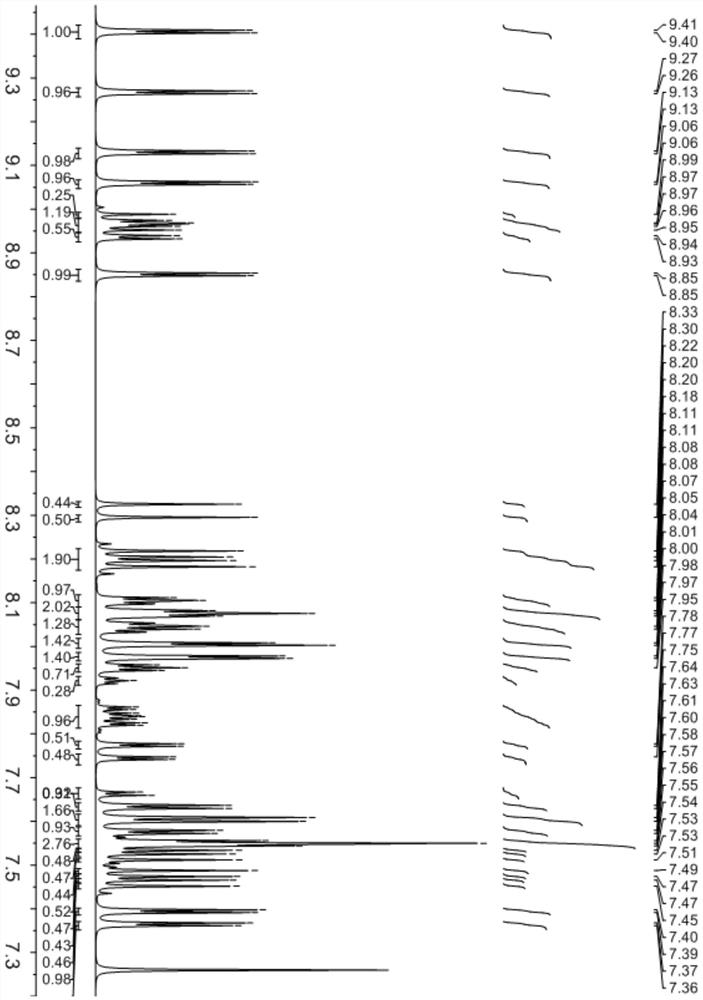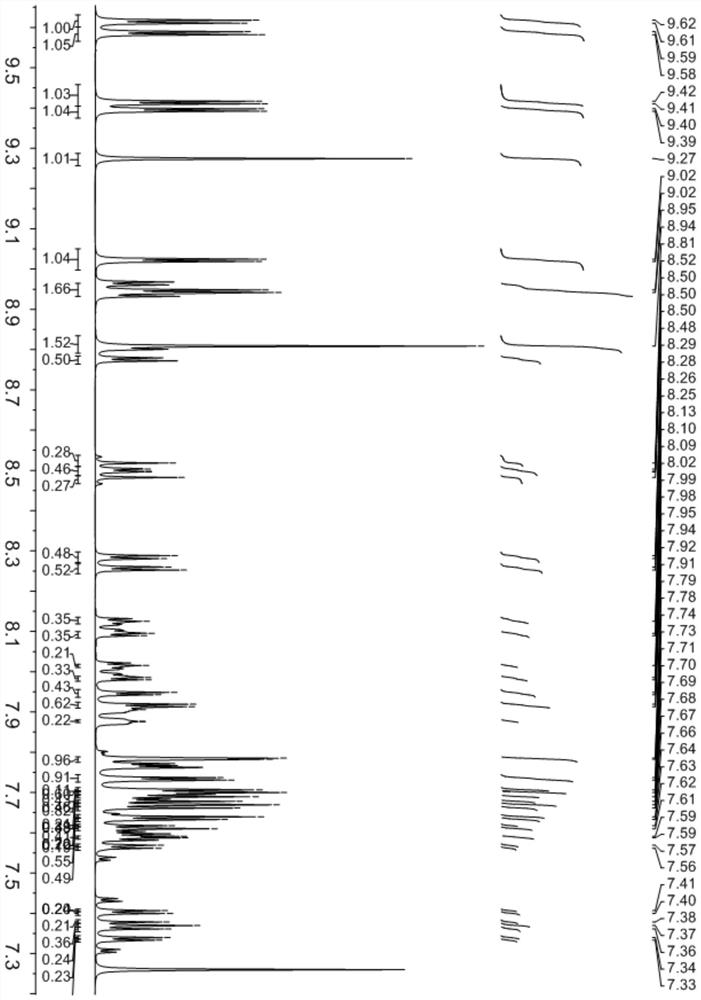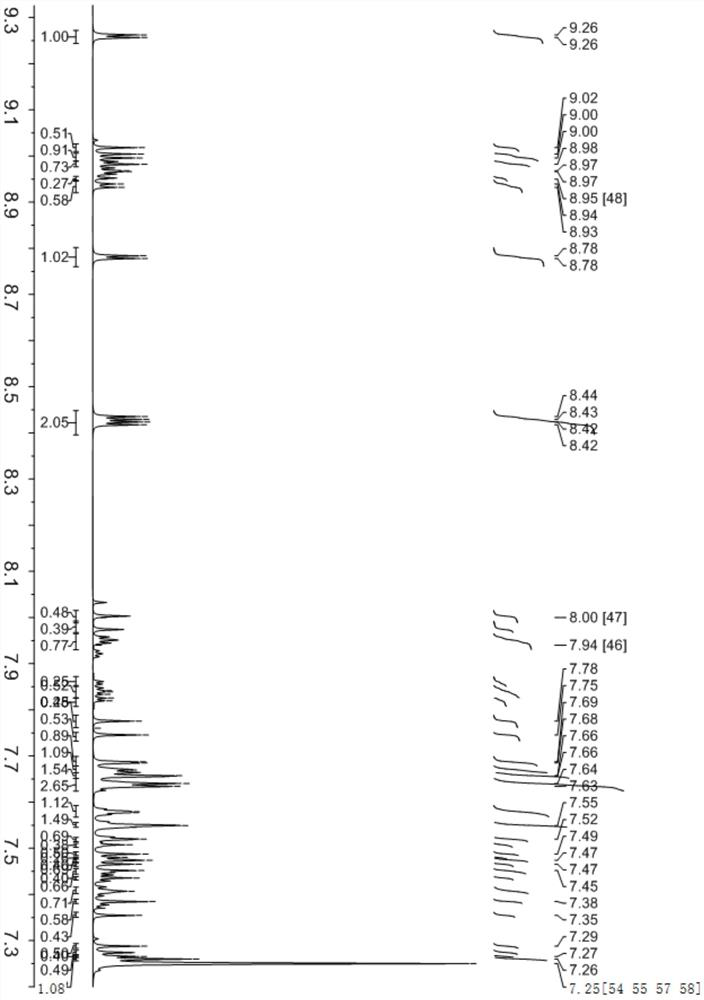A kind of condensed ring aromatic hydrocarbon derivative containing naphthyridine group and its application
A technology of condensed aromatic hydrocarbons and naphthyridine groups, which is applied in the field of organic electroluminescence, can solve the problems of increasing the complexity of the device manufacturing process, disadvantages, and reducing the cost of OLEDs, so as to achieve a good ability to accept electrons, reduce operating voltage, and improve luminescence efficiency effect
- Summary
- Abstract
- Description
- Claims
- Application Information
AI Technical Summary
Problems solved by technology
Method used
Image
Examples
Embodiment 1
[0064] Embodiment 1 The synthesis of various 3-bromo-7-aryl-1,5-naphthyridine derivative intermediates
[0065] Synthesis of 1,3-bromo-7-phenyl-1,5-naphthyridine
[0066]
[0067] 1000 ml three-necked flask equipped with magnetic stirring and nitrogen protection, add 5.72 g of 3,7-dibromo-1,5-naphthyridine (molecular weight 286, 0.02 mol), 2.7 g of phenylboronic acid (molecular weight 122, 0.022 mol), four ( (Triphenylphosphine) palladium 1.16g (molecular weight 1154, 0.001mol), 2M sodium carbonate aqueous solution 80ml, toluene 80ml, ethanol 80ml. After argon replacement, reflux at 80 ℃, use thin layer chromatography (TLC) method Monitor the reaction, after 4 hours TLC found that the raw material dibromo was reacted completely, only a monobromo product point. Cooling to 25 ℃, separate the organic layer, evaporate to dryness, column chromatography, ethyl acetate / petroleum ether eluting, obtain 5.77 g Target intermediate 3-bromo-7-phenyl-1,5-naphthyridine, molecular weight ...
Embodiment 2
[0075] Synthesis of compound shown in formula (14)
[0076]
[0077] 1000 ml bottle with magnetic stirring, add 5.68 g of 3-bromo-7-phenyl-1,5-naphthyridine (molecular weight 284, 0.02 mol), 9,10-di(naphthalene-2-yl)anthracene-2 - boric acid 11.0g (molecular weight 474, 0.022mol), tetrakis ((triphenylphosphine) palladium 1.16g (molecular weight 1154, 0.001mol), 2M aqueous sodium carbonate solution 80ml, toluene 80ml, ethanol 80ml. After argon replacement, Reflux at 80 DEG C, monitor the reaction with thin-layer chromatography (TLC), after 3.5 hours, TLC found that the raw material bromide reacted completely, and only the product point. Cooling, separate the organic layer, evaporate to dryness, column chromatography separation, ethyl acetate / Petroleum ether was rinsed to obtain 11.33 g of the compound represented by formula (14), with a molecular weight of 634 and a yield of 89.3%.
[0078] Product MS (m / e): 634, elemental analysis (C 48 h 30 N 2 ): theoretical value C:...
Embodiment 3
[0080] Synthesis of compound shown in formula (15)
[0081] The synthesis steps are the same as in Example 2, except that 3-bromo-7-phenyl-1,5-naphthyridine is changed to 3-bromo-7-(naphthalene-1-yl)-1,5-naphthyridine, other reagents Without changing, the compound represented by formula (15) is obtained.
[0082] Product MS (m / e): 684, elemental analysis (C 52 h 32 N 2 ): theoretical value C: 91.20%, H: 4.71%, N: 4.09%; measured value C: 91.23%, H: 4.73%, N: 4.04%, its nuclear magnetic spectrum ( 1 HNMR) see figure 1 shown.
PUM
 Login to View More
Login to View More Abstract
Description
Claims
Application Information
 Login to View More
Login to View More - R&D
- Intellectual Property
- Life Sciences
- Materials
- Tech Scout
- Unparalleled Data Quality
- Higher Quality Content
- 60% Fewer Hallucinations
Browse by: Latest US Patents, China's latest patents, Technical Efficacy Thesaurus, Application Domain, Technology Topic, Popular Technical Reports.
© 2025 PatSnap. All rights reserved.Legal|Privacy policy|Modern Slavery Act Transparency Statement|Sitemap|About US| Contact US: help@patsnap.com



